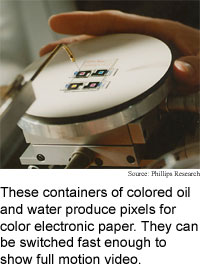
E-paper closes in on video
By
Eric Smalley,
Technology Research NewsBooks, newspapers and posters with moving pictures -- mainstays of the Harry Potter novels -- could become part of the real world before long.
Several electronic paper technologies are poised to deliver thin, flexible screens whose pictures rival the crispness of printed paper. Making pixels change fast enough to display video has been difficult, however.
Scientists from Philips Research in the Netherlands have come up with an electronic paper scheme that works fast enough to be used for video, draws little power, and paints a bright picture. It could also be used to control fluids in other technologies like labs-on-a-chip.
The key to electronic paper is electronic ink -- tiny amounts of substances that can be manipulated electrically like the pixels of a display screen.
The Philips electronic ink changes color when electricity alters the interface between water and a dyed oil, said Robert Hayes, a principal scientist at Philips Research. Other types of electronic ink use tiny colored particles suspended in fluid.
Each pixel of the Philips electronic ink is a thin sandwich of a white insulator that is hydrophobic, a film of colored oil, and water, said Hayes. "Because the insulator is hydrophobic the water does not want to contact it and the colored oil film lies in between."
The position of the colored oil can be changed by sending electric current to the insulator. In the presence of electricity "the surface properties of the insulator are changed to hydrophilic," said Hayes. "Water wants to contact the insulator and the colored oil film is moved aside like a curtain," he said.
The oil is pushed into a corner of the pixel, exposing about 70 percent of the background through the water. The change makes that portion of the pixel switch from the color of the oil to the white of the insulator background.
The pixels can be switched fast enough to show video, according to Hayes. It takes 13 milliseconds to turn a pixel 90 percent of the way on or off, which works out to switching more than 70 times per second. Full motion video images change 24 to 30 times per second. The oil and water scheme avoids the principal drawback to current particle-based electronic paper -- a slow switching time of about four times per second.
The Philips method can also be used to switch among two different layers of colored oil and the background, making each pixel able to reflect two colors. The researchers used cyan, magenta and yellow oils and combined three two-oil pixels with colored filters to make a single, full-color pixel. Cyan, magenta and yellow are used in the subtractive color mixing scheme of printing. Electronic displays use combinations of red, green and blue.
The three-in-one pixels make the screen brighter, according to Hayes. The researchers' single-color-and-white prototype has a reflectivity of 35 percent, and a three color display would have a reflectivity of 67 percent, versus 40 percent for particle-based electronic paper and 17 percent for liquid crystal displays, according to Hayes.
The oil films can be as close as 100 microns apart, which provides a wide viewing angle, according to Hayes. One hundred microns is one tenth of one millimeter, or about the thickness of a human hair.
The method is "a clever approach," said John Rogers, a professor of materials science and engineering at the University of Illinois. "It's interesting stuff, and has the potential to be an important technology," he said.
The approach is one of several technologies in the race to bring electronic paper to market. The Philips system offers some advantages, most notably speed, over other approaches, said Rogers. Ultimately the winning technology will be determined by a large number of considerations, including manufacturability, cost and reliability, he said. "It will be a good horserace."
The researchers are working on finding cost-effective manufacturing processes for the method, according to Hayes. The method could be ready for practical use in three to four years, he said.
The ultimate goal is to make colored electronic paper that has the ability to display moving pictures and that is bright enough to be easily viewed both indoors and outdoors, according to Hayes.
The same method could be used to control layers of fluid in other emerging technologies, including adaptive lenses, labs-on-a-chip, and pixelated optical filters, said Hayes.
Hayes's research colleague was B. J. Feenstra. The work appeared in the September 25 issue of Nature. The research was funded by Philips.
Timeline: 3-4 years
Funding: Corporate
TRN Categories: Materials Science and Engineering
Story Type: News
Related Elements: Technical paper, "Video-Speed Electronic Paper Based on Electrowetting," Nature, September 25, 2003
Advertisements:
October 8/15, 2003
Page One
E-paper closes in on video
Magnetic memory makes logic
Old idea retooled for security
Crystal slows and speeds light
News briefs:
Process orders nanowire arrays
CD writer generates holograms
Nanotubes boost storage
Nanotubes harvest electrons
Bacteria make more electricity
Design enables large neural nets

News:
Research News Roundup
Research Watch blog
Features:
View from the High Ground Q&A
How It Works
RSS Feeds:
News
Ad links:
Buy an ad link
| Advertisements:
|
 |
Ad links: Clear History
Buy an ad link
|
TRN
Newswire and Headline Feeds for Web sites
|
© Copyright Technology Research News, LLC 2000-2006. All rights reserved.